Remuneration System and Performance Management System Models
VerifiedAdded on 2022/11/11
|13
|2538
|117
AI Summary
This portfolio discusses the models of remuneration system and performance management system. It also includes the practices that support the prescribed models. It mentions the subject, course code, and course name. It is strictly under 165 characters.
Contribute Materials
Your contribution can guide someone’s learning journey. Share your
documents today.
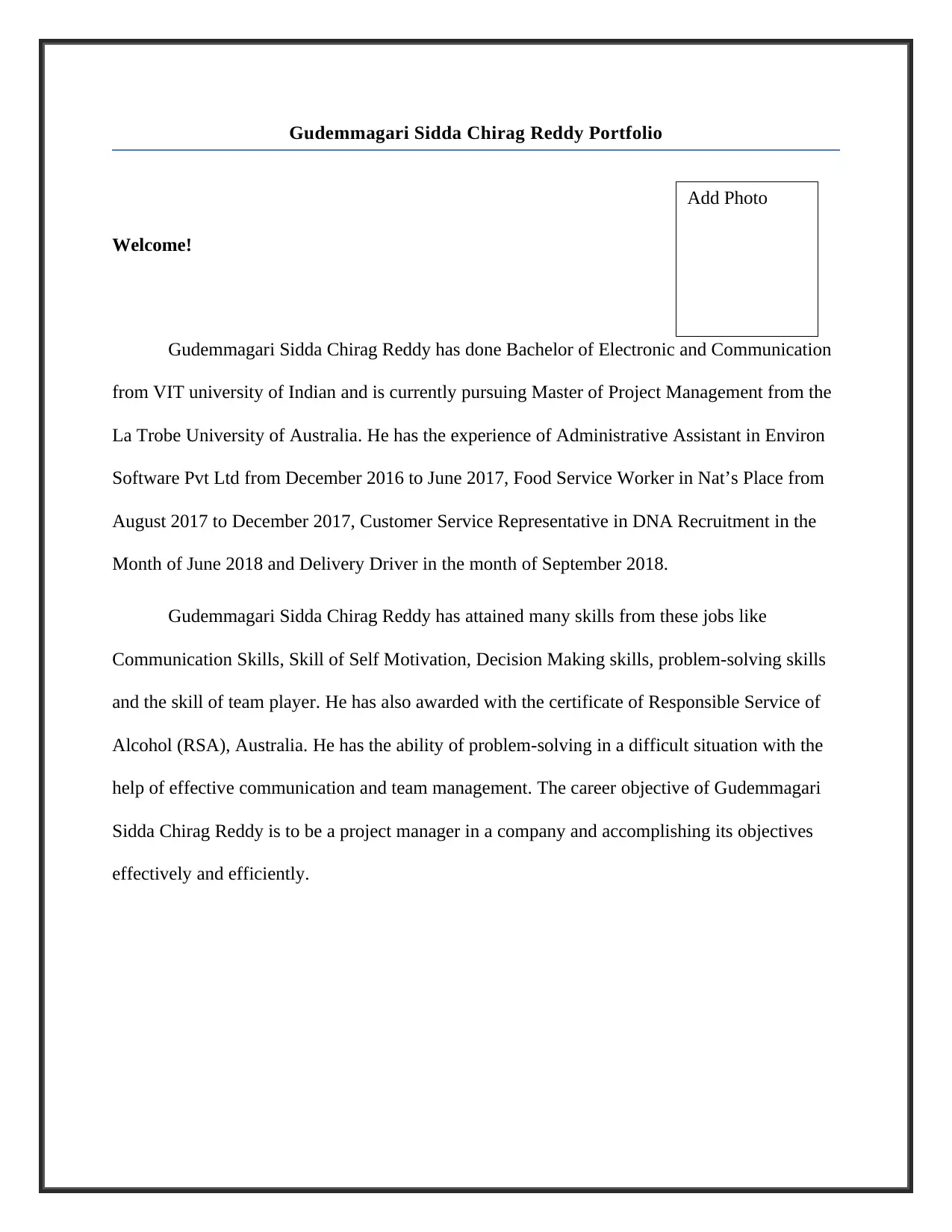
Gudemmagari Sidda Chirag Reddy Portfolio
Welcome!
Gudemmagari Sidda Chirag Reddy has done Bachelor of Electronic and Communication
from VIT university of Indian and is currently pursuing Master of Project Management from the
La Trobe University of Australia. He has the experience of Administrative Assistant in Environ
Software Pvt Ltd from December 2016 to June 2017, Food Service Worker in Nat’s Place from
August 2017 to December 2017, Customer Service Representative in DNA Recruitment in the
Month of June 2018 and Delivery Driver in the month of September 2018.
Gudemmagari Sidda Chirag Reddy has attained many skills from these jobs like
Communication Skills, Skill of Self Motivation, Decision Making skills, problem-solving skills
and the skill of team player. He has also awarded with the certificate of Responsible Service of
Alcohol (RSA), Australia. He has the ability of problem-solving in a difficult situation with the
help of effective communication and team management. The career objective of Gudemmagari
Sidda Chirag Reddy is to be a project manager in a company and accomplishing its objectives
effectively and efficiently.
Add Photo
Welcome!
Gudemmagari Sidda Chirag Reddy has done Bachelor of Electronic and Communication
from VIT university of Indian and is currently pursuing Master of Project Management from the
La Trobe University of Australia. He has the experience of Administrative Assistant in Environ
Software Pvt Ltd from December 2016 to June 2017, Food Service Worker in Nat’s Place from
August 2017 to December 2017, Customer Service Representative in DNA Recruitment in the
Month of June 2018 and Delivery Driver in the month of September 2018.
Gudemmagari Sidda Chirag Reddy has attained many skills from these jobs like
Communication Skills, Skill of Self Motivation, Decision Making skills, problem-solving skills
and the skill of team player. He has also awarded with the certificate of Responsible Service of
Alcohol (RSA), Australia. He has the ability of problem-solving in a difficult situation with the
help of effective communication and team management. The career objective of Gudemmagari
Sidda Chirag Reddy is to be a project manager in a company and accomplishing its objectives
effectively and efficiently.
Add Photo
Secure Best Marks with AI Grader
Need help grading? Try our AI Grader for instant feedback on your assignments.
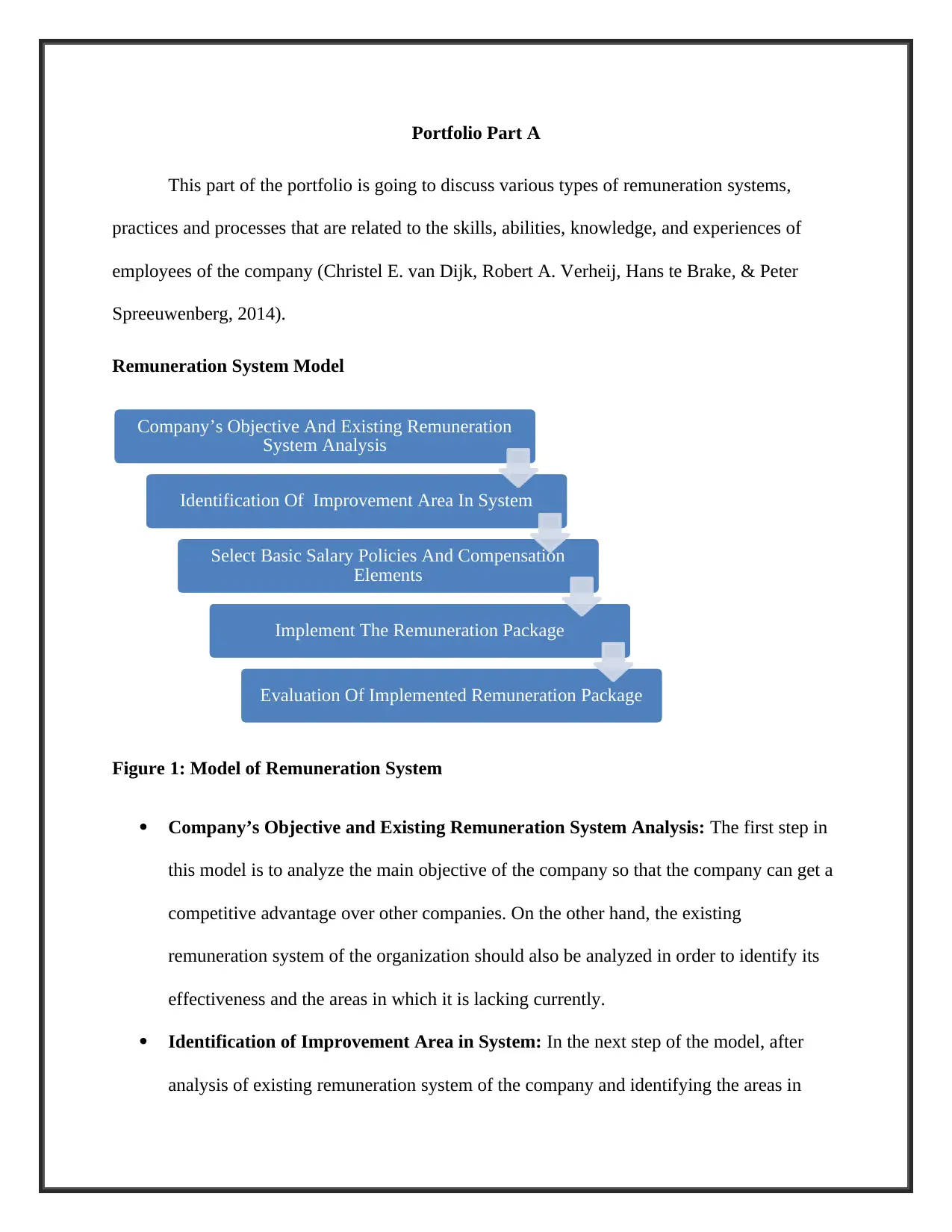
Portfolio Part A
This part of the portfolio is going to discuss various types of remuneration systems,
practices and processes that are related to the skills, abilities, knowledge, and experiences of
employees of the company (Christel E. van Dijk, Robert A. Verheij, Hans te Brake, & Peter
Spreeuwenberg, 2014).
Remuneration System Model
Figure 1: Model of Remuneration System
Company’s Objective and Existing Remuneration System Analysis: The first step in
this model is to analyze the main objective of the company so that the company can get a
competitive advantage over other companies. On the other hand, the existing
remuneration system of the organization should also be analyzed in order to identify its
effectiveness and the areas in which it is lacking currently.
Identification of Improvement Area in System: In the next step of the model, after
analysis of existing remuneration system of the company and identifying the areas in
Company’s Objective And Existing Remuneration
System Analysis
Identification Of Improvement Area In System
Select Basic Salary Policies And Compensation
Elements
Implement The Remuneration Package
Evaluation Of Implemented Remuneration Package
This part of the portfolio is going to discuss various types of remuneration systems,
practices and processes that are related to the skills, abilities, knowledge, and experiences of
employees of the company (Christel E. van Dijk, Robert A. Verheij, Hans te Brake, & Peter
Spreeuwenberg, 2014).
Remuneration System Model
Figure 1: Model of Remuneration System
Company’s Objective and Existing Remuneration System Analysis: The first step in
this model is to analyze the main objective of the company so that the company can get a
competitive advantage over other companies. On the other hand, the existing
remuneration system of the organization should also be analyzed in order to identify its
effectiveness and the areas in which it is lacking currently.
Identification of Improvement Area in System: In the next step of the model, after
analysis of existing remuneration system of the company and identifying the areas in
Company’s Objective And Existing Remuneration
System Analysis
Identification Of Improvement Area In System
Select Basic Salary Policies And Compensation
Elements
Implement The Remuneration Package
Evaluation Of Implemented Remuneration Package
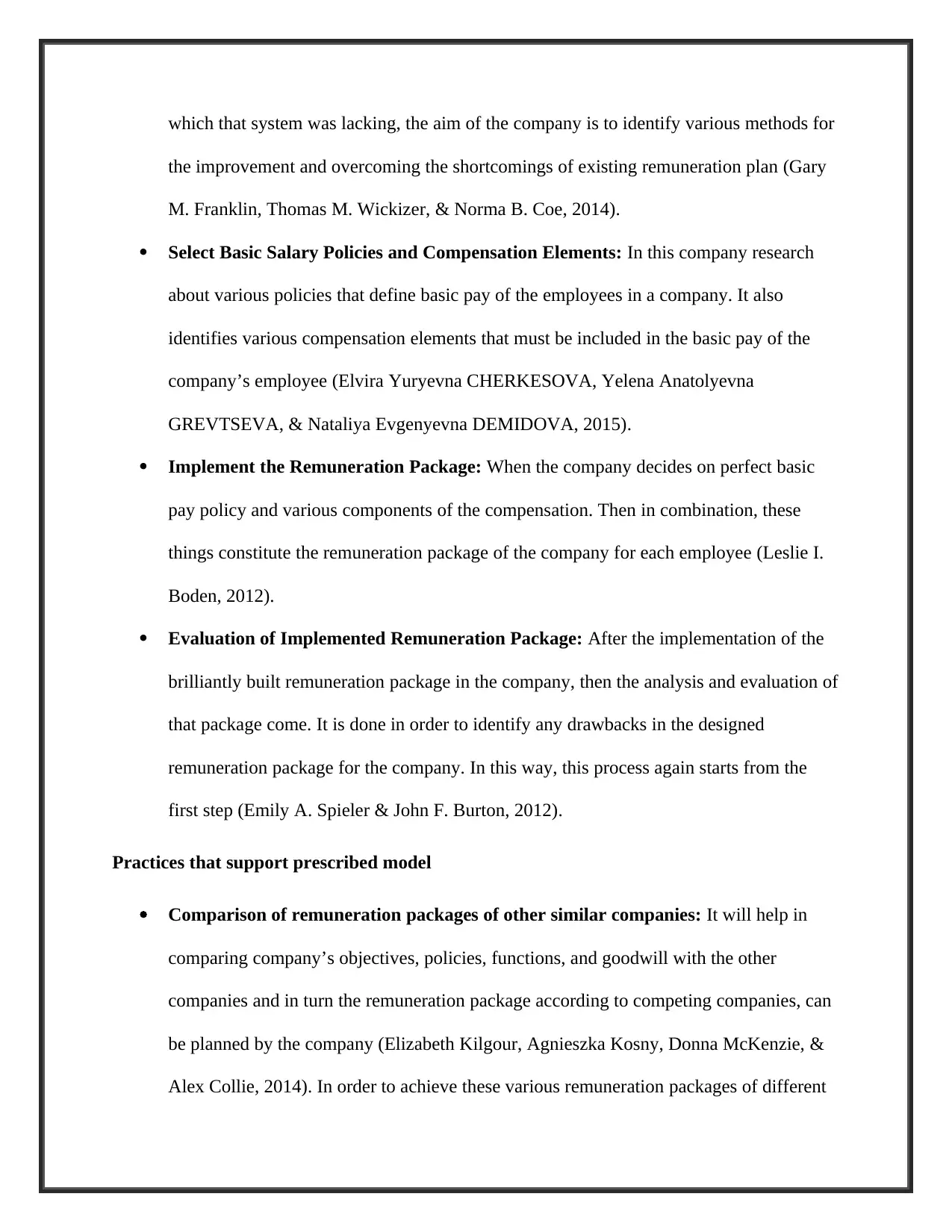
which that system was lacking, the aim of the company is to identify various methods for
the improvement and overcoming the shortcomings of existing remuneration plan (Gary
M. Franklin, Thomas M. Wickizer, & Norma B. Coe, 2014).
Select Basic Salary Policies and Compensation Elements: In this company research
about various policies that define basic pay of the employees in a company. It also
identifies various compensation elements that must be included in the basic pay of the
company’s employee (Elvira Yuryevna CHERKESOVA, Yelena Anatolyevna
GREVTSEVA, & Nataliya Evgenyevna DEMIDOVA, 2015).
Implement the Remuneration Package: When the company decides on perfect basic
pay policy and various components of the compensation. Then in combination, these
things constitute the remuneration package of the company for each employee (Leslie I.
Boden, 2012).
Evaluation of Implemented Remuneration Package: After the implementation of the
brilliantly built remuneration package in the company, then the analysis and evaluation of
that package come. It is done in order to identify any drawbacks in the designed
remuneration package for the company. In this way, this process again starts from the
first step (Emily A. Spieler & John F. Burton, 2012).
Practices that support prescribed model
Comparison of remuneration packages of other similar companies: It will help in
comparing company’s objectives, policies, functions, and goodwill with the other
companies and in turn the remuneration package according to competing companies, can
be planned by the company (Elizabeth Kilgour, Agnieszka Kosny, Donna McKenzie, &
Alex Collie, 2014). In order to achieve these various remuneration packages of different
the improvement and overcoming the shortcomings of existing remuneration plan (Gary
M. Franklin, Thomas M. Wickizer, & Norma B. Coe, 2014).
Select Basic Salary Policies and Compensation Elements: In this company research
about various policies that define basic pay of the employees in a company. It also
identifies various compensation elements that must be included in the basic pay of the
company’s employee (Elvira Yuryevna CHERKESOVA, Yelena Anatolyevna
GREVTSEVA, & Nataliya Evgenyevna DEMIDOVA, 2015).
Implement the Remuneration Package: When the company decides on perfect basic
pay policy and various components of the compensation. Then in combination, these
things constitute the remuneration package of the company for each employee (Leslie I.
Boden, 2012).
Evaluation of Implemented Remuneration Package: After the implementation of the
brilliantly built remuneration package in the company, then the analysis and evaluation of
that package come. It is done in order to identify any drawbacks in the designed
remuneration package for the company. In this way, this process again starts from the
first step (Emily A. Spieler & John F. Burton, 2012).
Practices that support prescribed model
Comparison of remuneration packages of other similar companies: It will help in
comparing company’s objectives, policies, functions, and goodwill with the other
companies and in turn the remuneration package according to competing companies, can
be planned by the company (Elizabeth Kilgour, Agnieszka Kosny, Donna McKenzie, &
Alex Collie, 2014). In order to achieve these various remuneration packages of different
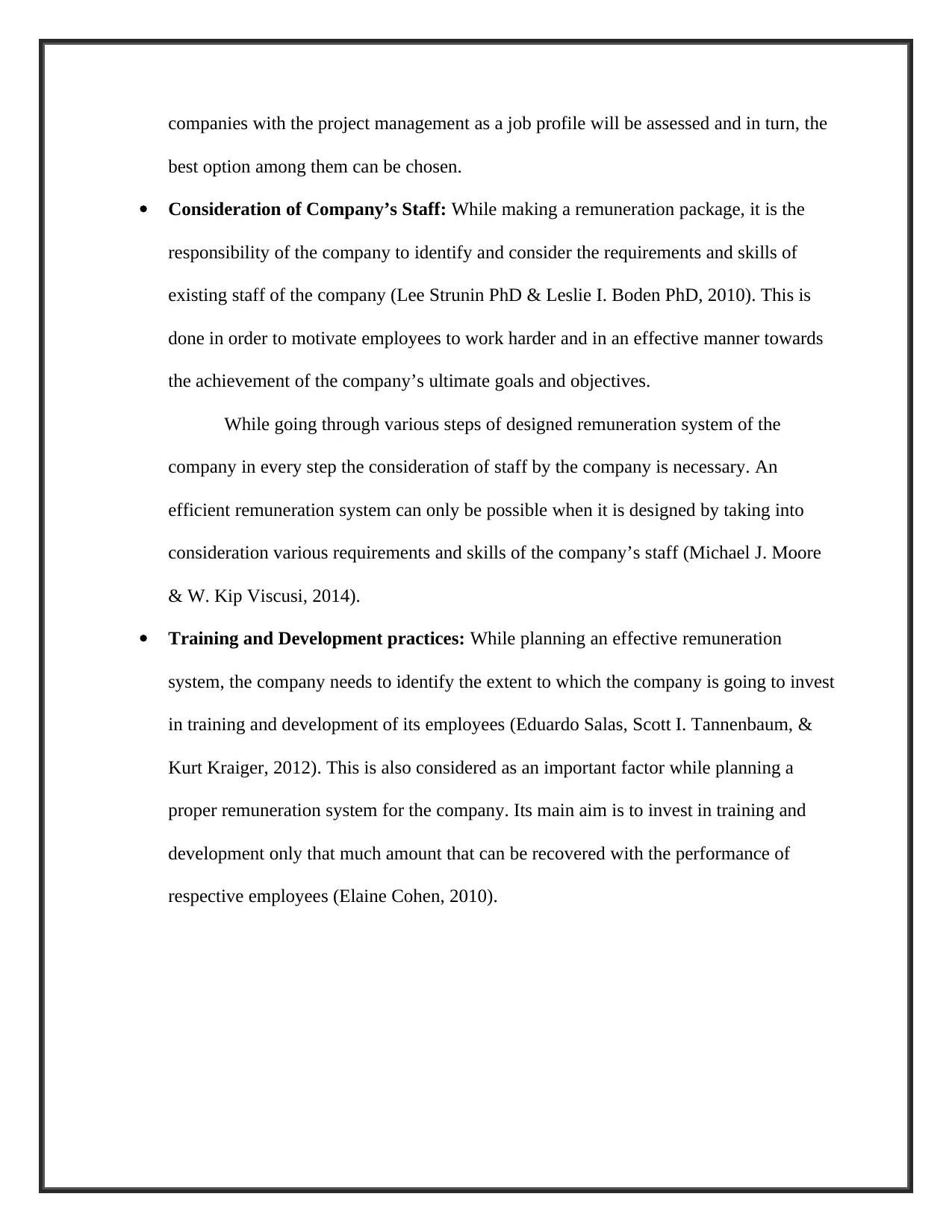
companies with the project management as a job profile will be assessed and in turn, the
best option among them can be chosen.
Consideration of Company’s Staff: While making a remuneration package, it is the
responsibility of the company to identify and consider the requirements and skills of
existing staff of the company (Lee Strunin PhD & Leslie I. Boden PhD, 2010). This is
done in order to motivate employees to work harder and in an effective manner towards
the achievement of the company’s ultimate goals and objectives.
While going through various steps of designed remuneration system of the
company in every step the consideration of staff by the company is necessary. An
efficient remuneration system can only be possible when it is designed by taking into
consideration various requirements and skills of the company’s staff (Michael J. Moore
& W. Kip Viscusi, 2014).
Training and Development practices: While planning an effective remuneration
system, the company needs to identify the extent to which the company is going to invest
in training and development of its employees (Eduardo Salas, Scott I. Tannenbaum, &
Kurt Kraiger, 2012). This is also considered as an important factor while planning a
proper remuneration system for the company. Its main aim is to invest in training and
development only that much amount that can be recovered with the performance of
respective employees (Elaine Cohen, 2010).
best option among them can be chosen.
Consideration of Company’s Staff: While making a remuneration package, it is the
responsibility of the company to identify and consider the requirements and skills of
existing staff of the company (Lee Strunin PhD & Leslie I. Boden PhD, 2010). This is
done in order to motivate employees to work harder and in an effective manner towards
the achievement of the company’s ultimate goals and objectives.
While going through various steps of designed remuneration system of the
company in every step the consideration of staff by the company is necessary. An
efficient remuneration system can only be possible when it is designed by taking into
consideration various requirements and skills of the company’s staff (Michael J. Moore
& W. Kip Viscusi, 2014).
Training and Development practices: While planning an effective remuneration
system, the company needs to identify the extent to which the company is going to invest
in training and development of its employees (Eduardo Salas, Scott I. Tannenbaum, &
Kurt Kraiger, 2012). This is also considered as an important factor while planning a
proper remuneration system for the company. Its main aim is to invest in training and
development only that much amount that can be recovered with the performance of
respective employees (Elaine Cohen, 2010).
Secure Best Marks with AI Grader
Need help grading? Try our AI Grader for instant feedback on your assignments.
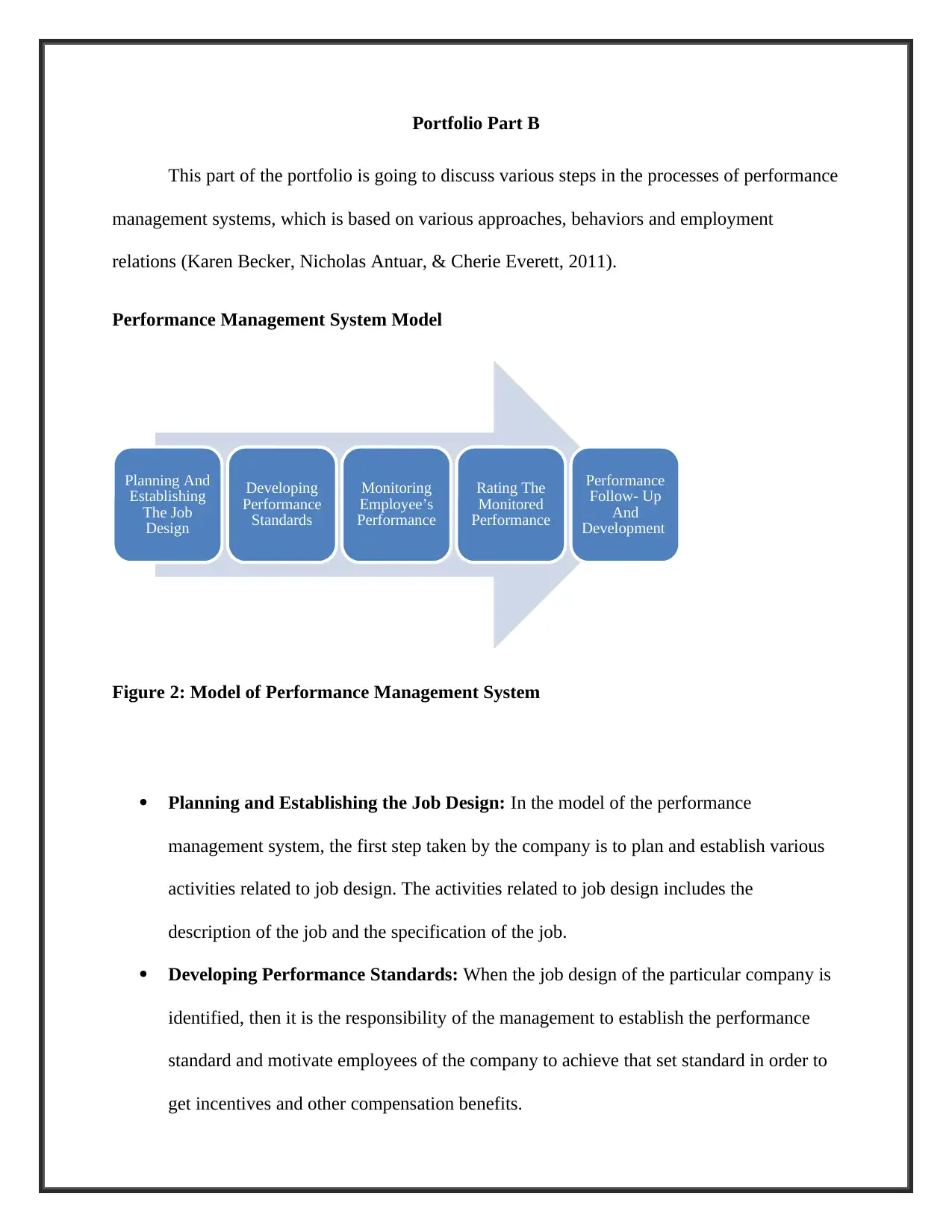
Portfolio Part B
This part of the portfolio is going to discuss various steps in the processes of performance
management systems, which is based on various approaches, behaviors and employment
relations (Karen Becker, Nicholas Antuar, & Cherie Everett, 2011).
Performance Management System Model
Figure 2: Model of Performance Management System
Planning and Establishing the Job Design: In the model of the performance
management system, the first step taken by the company is to plan and establish various
activities related to job design. The activities related to job design includes the
description of the job and the specification of the job.
Developing Performance Standards: When the job design of the particular company is
identified, then it is the responsibility of the management to establish the performance
standard and motivate employees of the company to achieve that set standard in order to
get incentives and other compensation benefits.
Planning And
Establishing
The Job
Design
Developing
Performance
Standards
Monitoring
Employee’s
Performance
Rating The
Monitored
Performance
Performance
Follow- Up
And
Development
This part of the portfolio is going to discuss various steps in the processes of performance
management systems, which is based on various approaches, behaviors and employment
relations (Karen Becker, Nicholas Antuar, & Cherie Everett, 2011).
Performance Management System Model
Figure 2: Model of Performance Management System
Planning and Establishing the Job Design: In the model of the performance
management system, the first step taken by the company is to plan and establish various
activities related to job design. The activities related to job design includes the
description of the job and the specification of the job.
Developing Performance Standards: When the job design of the particular company is
identified, then it is the responsibility of the management to establish the performance
standard and motivate employees of the company to achieve that set standard in order to
get incentives and other compensation benefits.
Planning And
Establishing
The Job
Design
Developing
Performance
Standards
Monitoring
Employee’s
Performance
Rating The
Monitored
Performance
Performance
Follow- Up
And
Development
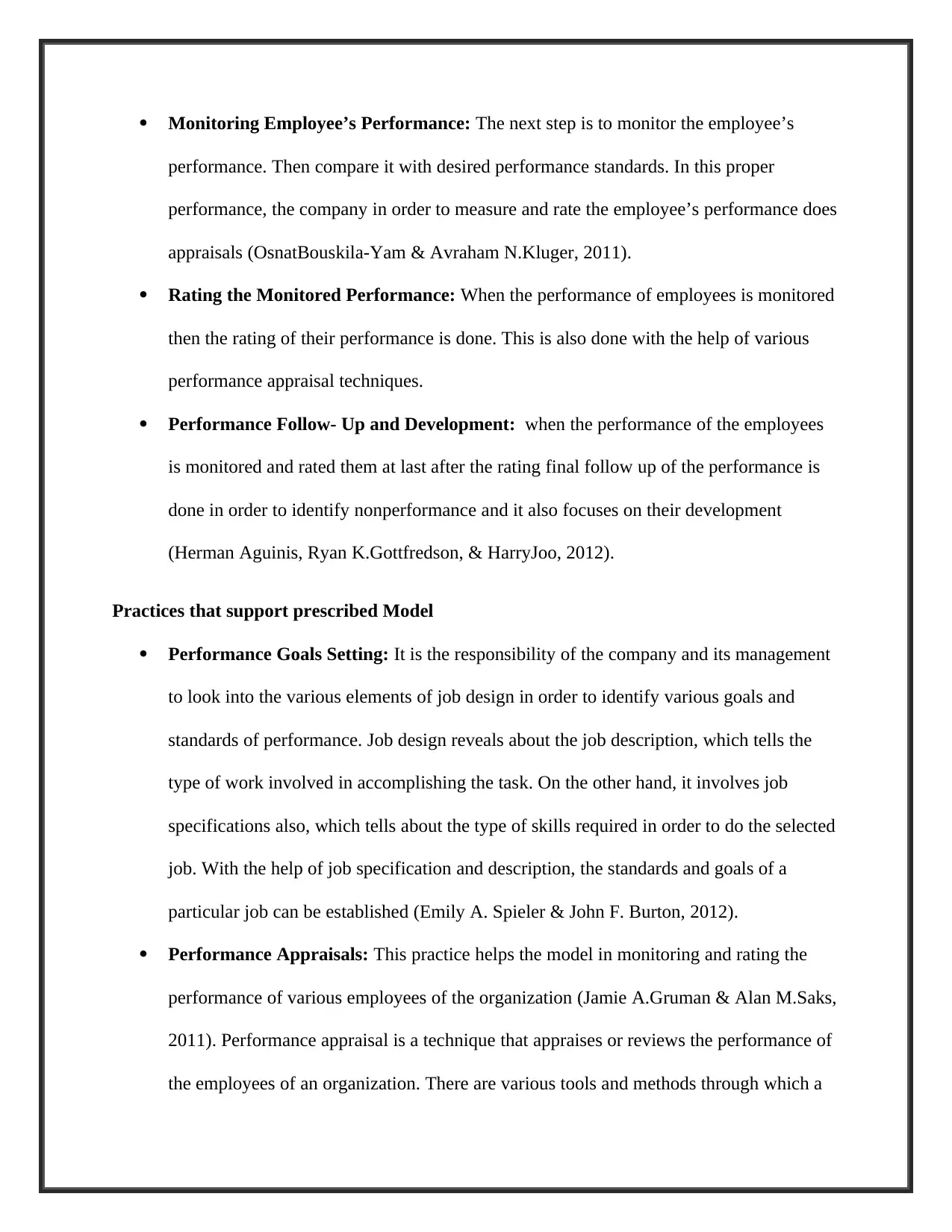
Monitoring Employee’s Performance: The next step is to monitor the employee’s
performance. Then compare it with desired performance standards. In this proper
performance, the company in order to measure and rate the employee’s performance does
appraisals (OsnatBouskila-Yam & Avraham N.Kluger, 2011).
Rating the Monitored Performance: When the performance of employees is monitored
then the rating of their performance is done. This is also done with the help of various
performance appraisal techniques.
Performance Follow- Up and Development: when the performance of the employees
is monitored and rated them at last after the rating final follow up of the performance is
done in order to identify nonperformance and it also focuses on their development
(Herman Aguinis, Ryan K.Gottfredson, & HarryJoo, 2012).
Practices that support prescribed Model
Performance Goals Setting: It is the responsibility of the company and its management
to look into the various elements of job design in order to identify various goals and
standards of performance. Job design reveals about the job description, which tells the
type of work involved in accomplishing the task. On the other hand, it involves job
specifications also, which tells about the type of skills required in order to do the selected
job. With the help of job specification and description, the standards and goals of a
particular job can be established (Emily A. Spieler & John F. Burton, 2012).
Performance Appraisals: This practice helps the model in monitoring and rating the
performance of various employees of the organization (Jamie A.Gruman & Alan M.Saks,
2011). Performance appraisal is a technique that appraises or reviews the performance of
the employees of an organization. There are various tools and methods through which a
performance. Then compare it with desired performance standards. In this proper
performance, the company in order to measure and rate the employee’s performance does
appraisals (OsnatBouskila-Yam & Avraham N.Kluger, 2011).
Rating the Monitored Performance: When the performance of employees is monitored
then the rating of their performance is done. This is also done with the help of various
performance appraisal techniques.
Performance Follow- Up and Development: when the performance of the employees
is monitored and rated them at last after the rating final follow up of the performance is
done in order to identify nonperformance and it also focuses on their development
(Herman Aguinis, Ryan K.Gottfredson, & HarryJoo, 2012).
Practices that support prescribed Model
Performance Goals Setting: It is the responsibility of the company and its management
to look into the various elements of job design in order to identify various goals and
standards of performance. Job design reveals about the job description, which tells the
type of work involved in accomplishing the task. On the other hand, it involves job
specifications also, which tells about the type of skills required in order to do the selected
job. With the help of job specification and description, the standards and goals of a
particular job can be established (Emily A. Spieler & John F. Burton, 2012).
Performance Appraisals: This practice helps the model in monitoring and rating the
performance of various employees of the organization (Jamie A.Gruman & Alan M.Saks,
2011). Performance appraisal is a technique that appraises or reviews the performance of
the employees of an organization. There are various tools and methods through which a
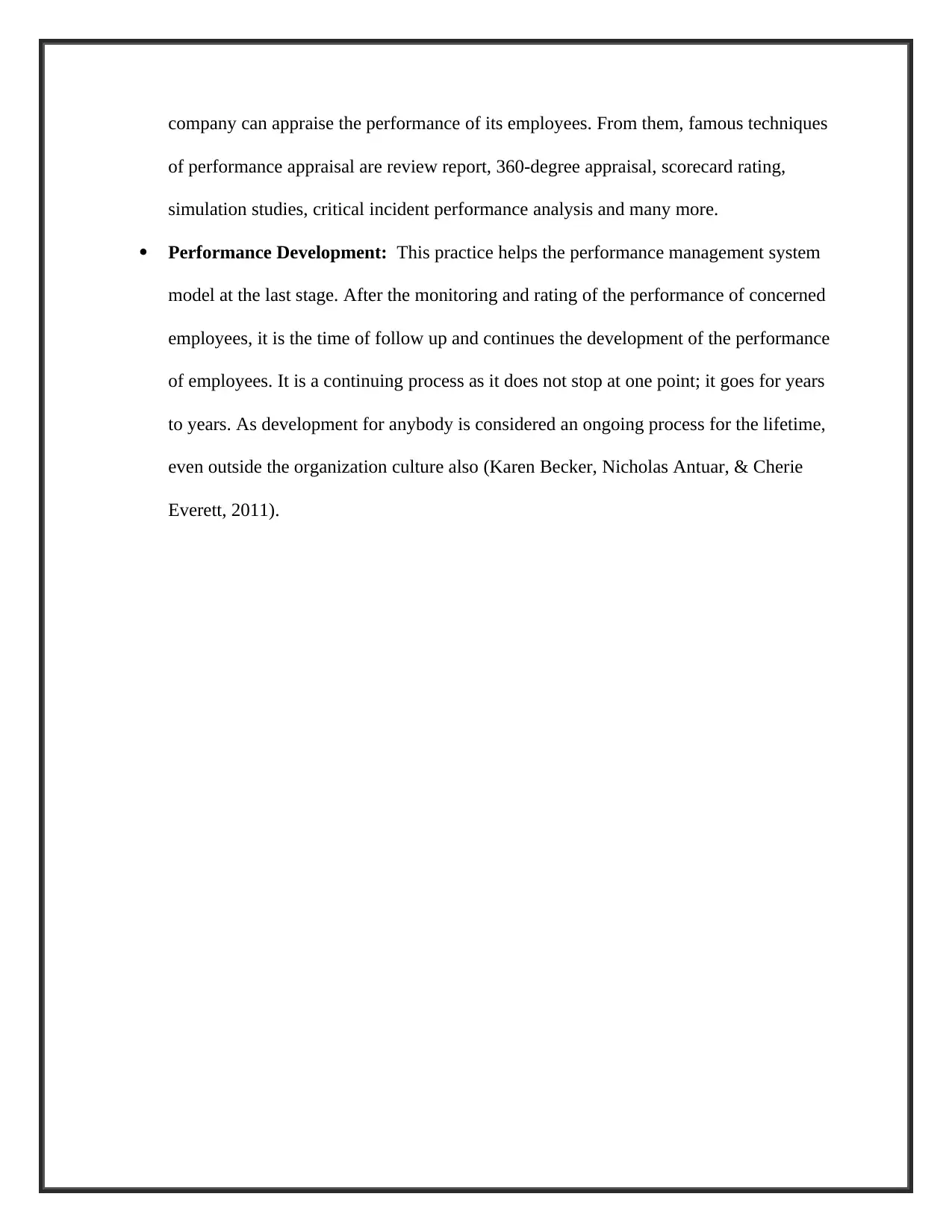
company can appraise the performance of its employees. From them, famous techniques
of performance appraisal are review report, 360-degree appraisal, scorecard rating,
simulation studies, critical incident performance analysis and many more.
Performance Development: This practice helps the performance management system
model at the last stage. After the monitoring and rating of the performance of concerned
employees, it is the time of follow up and continues the development of the performance
of employees. It is a continuing process as it does not stop at one point; it goes for years
to years. As development for anybody is considered an ongoing process for the lifetime,
even outside the organization culture also (Karen Becker, Nicholas Antuar, & Cherie
Everett, 2011).
of performance appraisal are review report, 360-degree appraisal, scorecard rating,
simulation studies, critical incident performance analysis and many more.
Performance Development: This practice helps the performance management system
model at the last stage. After the monitoring and rating of the performance of concerned
employees, it is the time of follow up and continues the development of the performance
of employees. It is a continuing process as it does not stop at one point; it goes for years
to years. As development for anybody is considered an ongoing process for the lifetime,
even outside the organization culture also (Karen Becker, Nicholas Antuar, & Cherie
Everett, 2011).
Paraphrase This Document
Need a fresh take? Get an instant paraphrase of this document with our AI Paraphraser
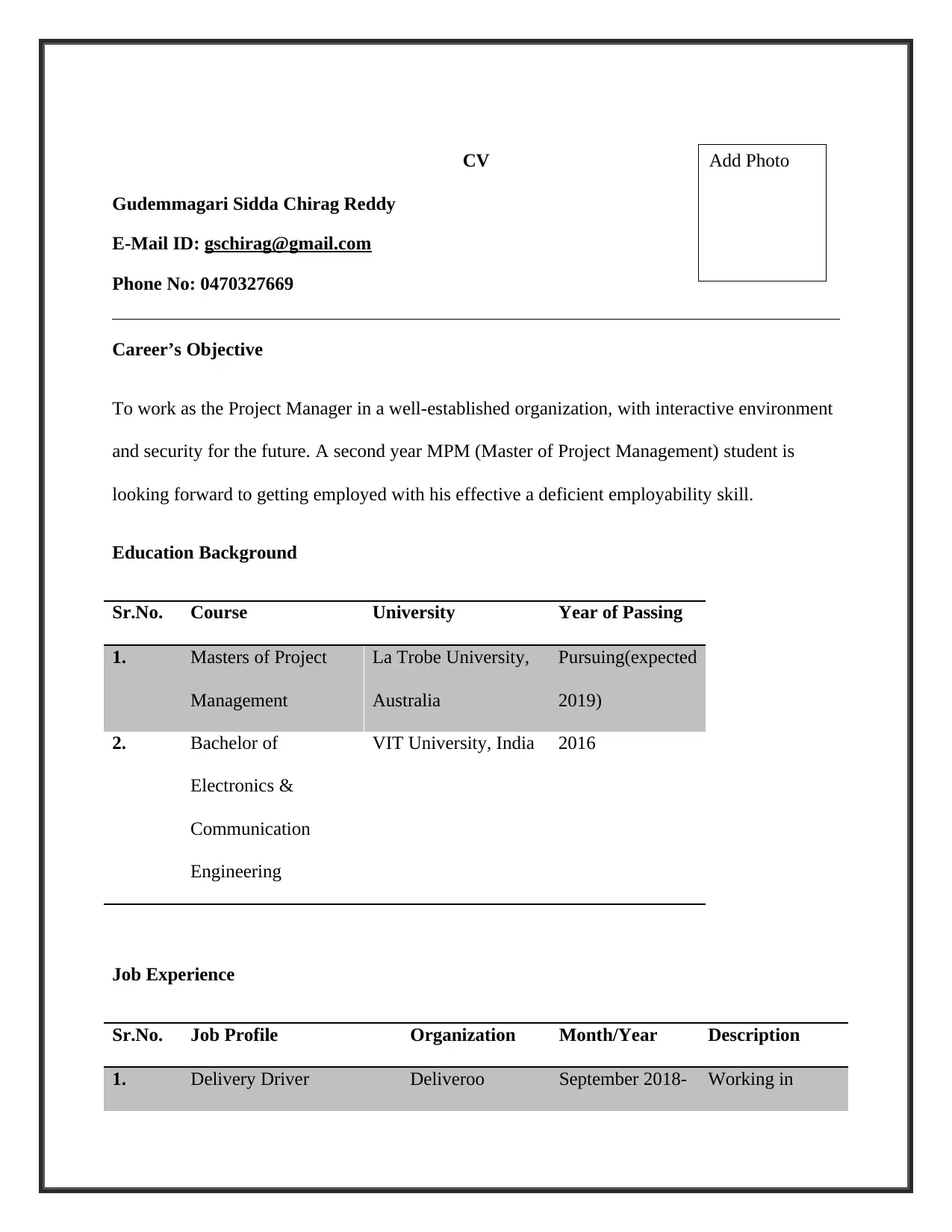
CV
Gudemmagari Sidda Chirag Reddy
E-Mail ID: gschirag@gmail.com
Phone No: 0470327669
Career’s Objective
To work as the Project Manager in a well-established organization, with interactive environment
and security for the future. A second year MPM (Master of Project Management) student is
looking forward to getting employed with his effective a deficient employability skill.
Education Background
Sr.No. Course University Year of Passing
1. Masters of Project
Management
La Trobe University,
Australia
Pursuing(expected
2019)
2. Bachelor of
Electronics &
Communication
Engineering
VIT University, India 2016
Job Experience
Sr.No. Job Profile Organization Month/Year Description
1. Delivery Driver Deliveroo September 2018- Working in
Add Photo
Gudemmagari Sidda Chirag Reddy
E-Mail ID: gschirag@gmail.com
Phone No: 0470327669
Career’s Objective
To work as the Project Manager in a well-established organization, with interactive environment
and security for the future. A second year MPM (Master of Project Management) student is
looking forward to getting employed with his effective a deficient employability skill.
Education Background
Sr.No. Course University Year of Passing
1. Masters of Project
Management
La Trobe University,
Australia
Pursuing(expected
2019)
2. Bachelor of
Electronics &
Communication
Engineering
VIT University, India 2016
Job Experience
Sr.No. Job Profile Organization Month/Year Description
1. Delivery Driver Deliveroo September 2018- Working in
Add Photo
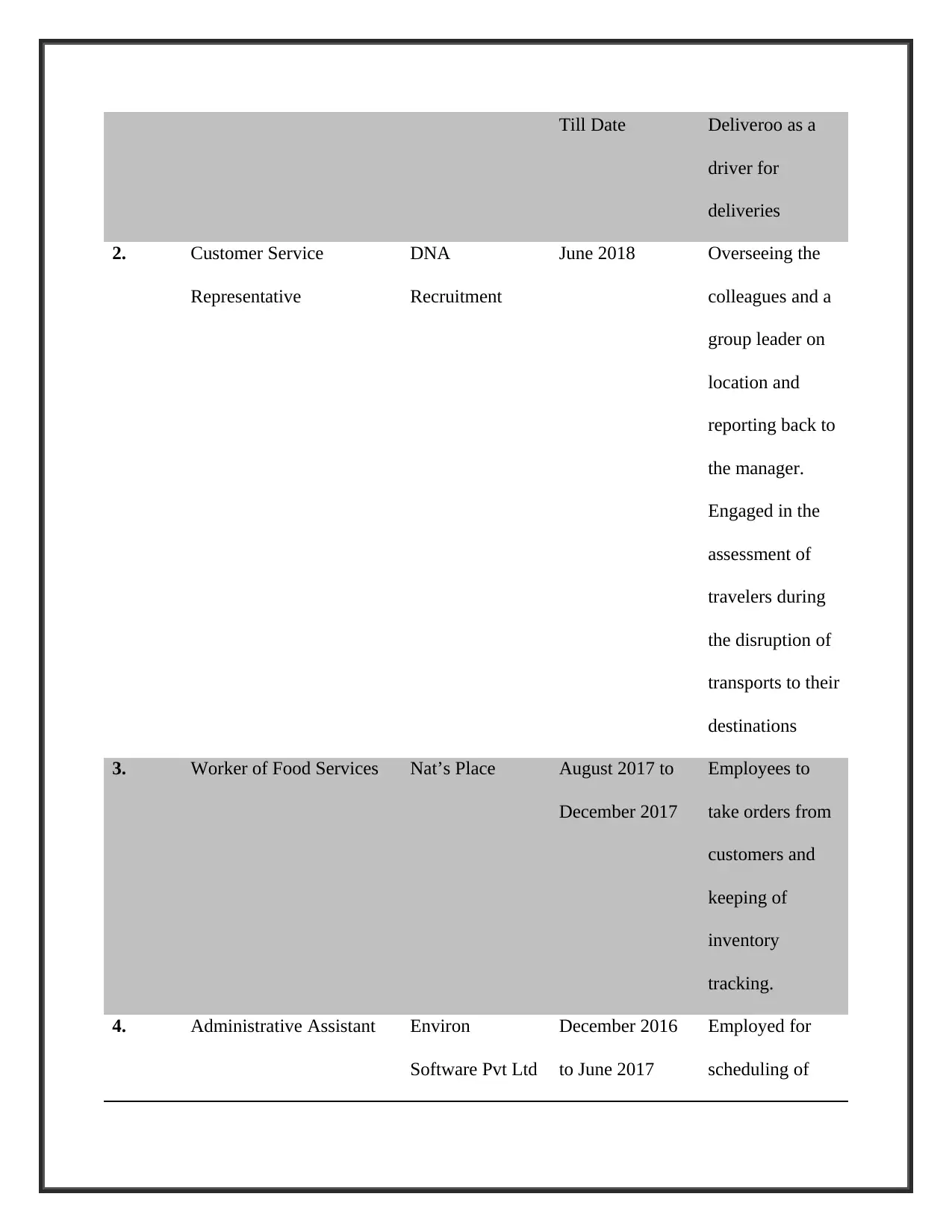
Till Date Deliveroo as a
driver for
deliveries
2. Customer Service
Representative
DNA
Recruitment
June 2018 Overseeing the
colleagues and a
group leader on
location and
reporting back to
the manager.
Engaged in the
assessment of
travelers during
the disruption of
transports to their
destinations
3. Worker of Food Services Nat’s Place August 2017 to
December 2017
Employees to
take orders from
customers and
keeping of
inventory
tracking.
4. Administrative Assistant Environ
Software Pvt Ltd
December 2016
to June 2017
Employed for
scheduling of
driver for
deliveries
2. Customer Service
Representative
DNA
Recruitment
June 2018 Overseeing the
colleagues and a
group leader on
location and
reporting back to
the manager.
Engaged in the
assessment of
travelers during
the disruption of
transports to their
destinations
3. Worker of Food Services Nat’s Place August 2017 to
December 2017
Employees to
take orders from
customers and
keeping of
inventory
tracking.
4. Administrative Assistant Environ
Software Pvt Ltd
December 2016
to June 2017
Employed for
scheduling of
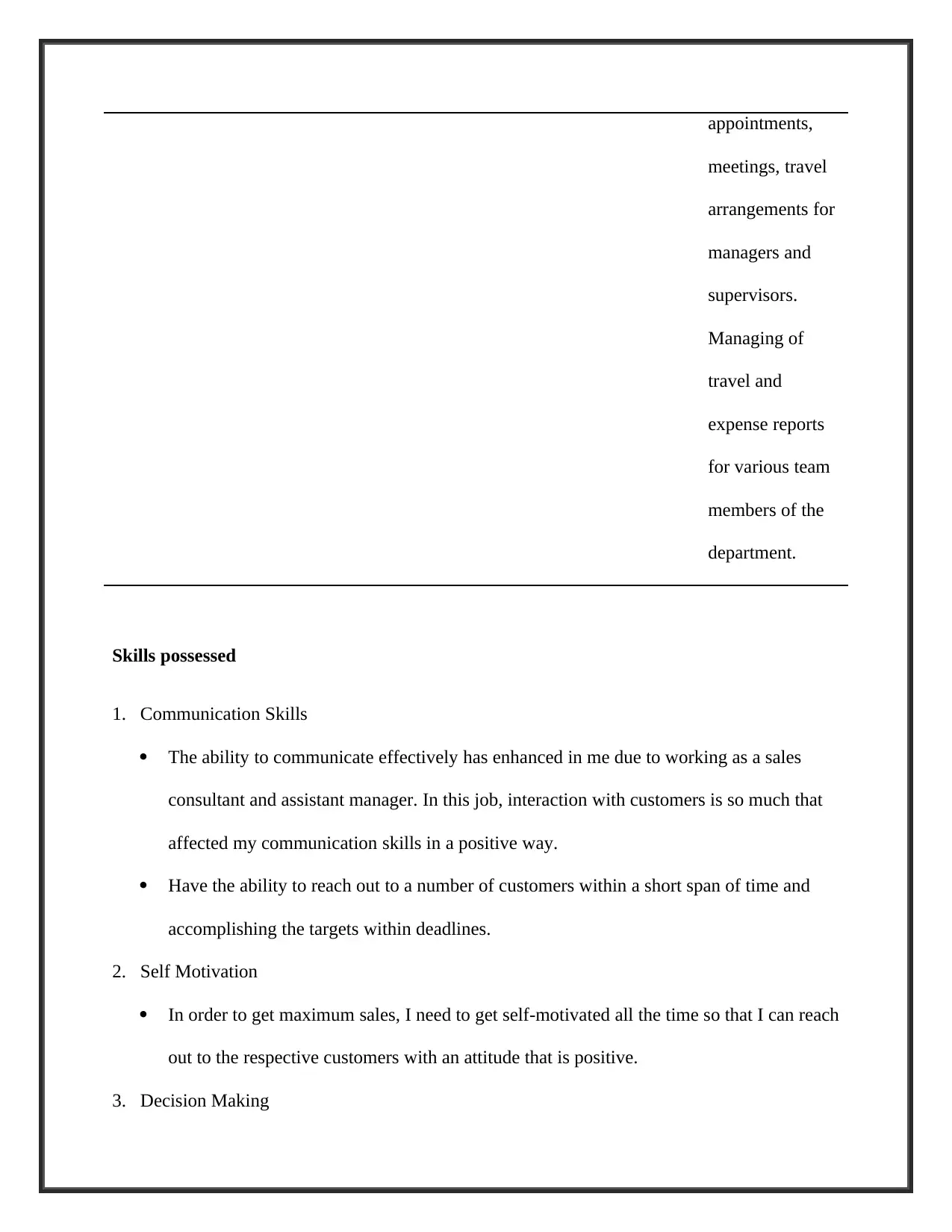
appointments,
meetings, travel
arrangements for
managers and
supervisors.
Managing of
travel and
expense reports
for various team
members of the
department.
Skills possessed
1. Communication Skills
The ability to communicate effectively has enhanced in me due to working as a sales
consultant and assistant manager. In this job, interaction with customers is so much that
affected my communication skills in a positive way.
Have the ability to reach out to a number of customers within a short span of time and
accomplishing the targets within deadlines.
2. Self Motivation
In order to get maximum sales, I need to get self-motivated all the time so that I can reach
out to the respective customers with an attitude that is positive.
3. Decision Making
meetings, travel
arrangements for
managers and
supervisors.
Managing of
travel and
expense reports
for various team
members of the
department.
Skills possessed
1. Communication Skills
The ability to communicate effectively has enhanced in me due to working as a sales
consultant and assistant manager. In this job, interaction with customers is so much that
affected my communication skills in a positive way.
Have the ability to reach out to a number of customers within a short span of time and
accomplishing the targets within deadlines.
2. Self Motivation
In order to get maximum sales, I need to get self-motivated all the time so that I can reach
out to the respective customers with an attitude that is positive.
3. Decision Making
Secure Best Marks with AI Grader
Need help grading? Try our AI Grader for instant feedback on your assignments.
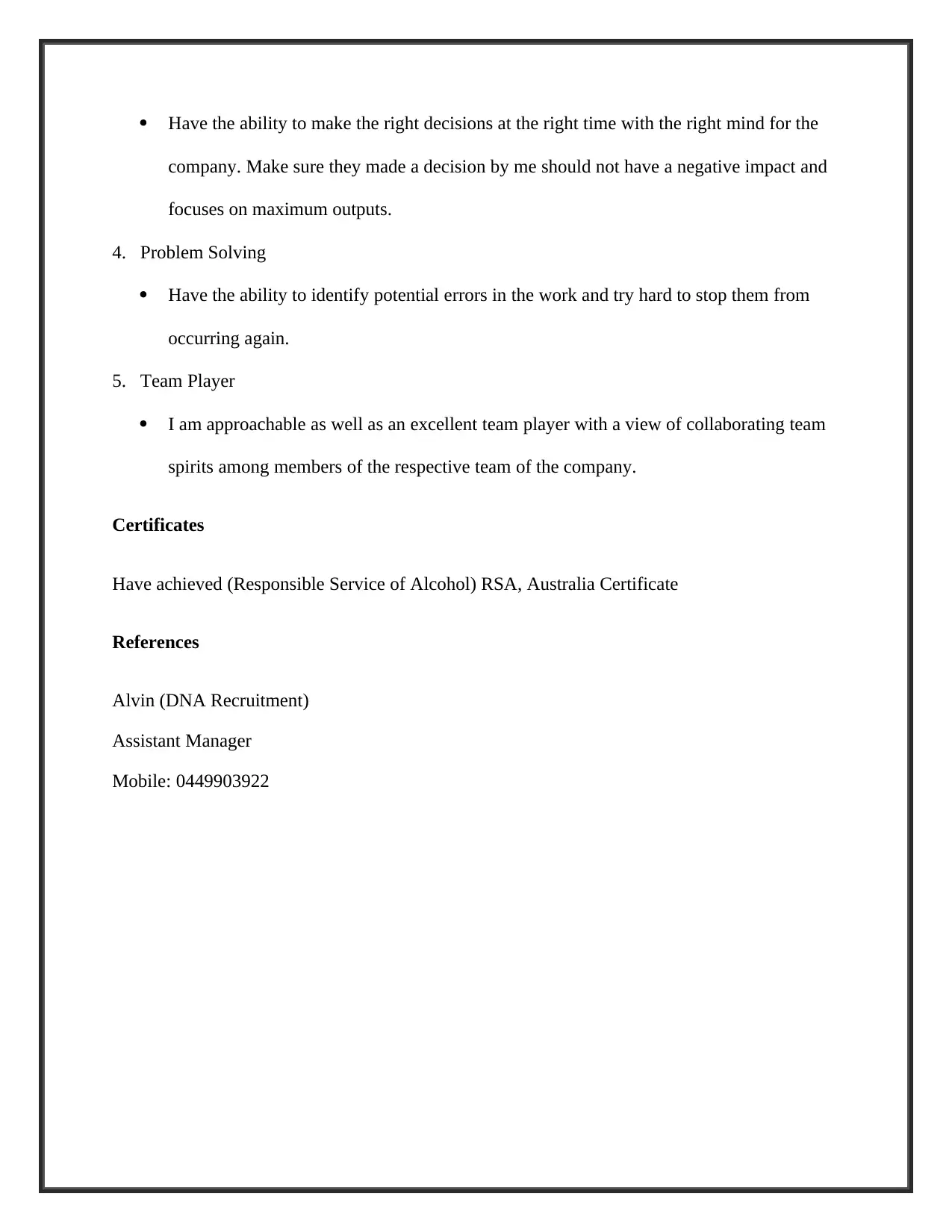
Have the ability to make the right decisions at the right time with the right mind for the
company. Make sure they made a decision by me should not have a negative impact and
focuses on maximum outputs.
4. Problem Solving
Have the ability to identify potential errors in the work and try hard to stop them from
occurring again.
5. Team Player
I am approachable as well as an excellent team player with a view of collaborating team
spirits among members of the respective team of the company.
Certificates
Have achieved (Responsible Service of Alcohol) RSA, Australia Certificate
References
Alvin (DNA Recruitment)
Assistant Manager
Mobile: 0449903922
company. Make sure they made a decision by me should not have a negative impact and
focuses on maximum outputs.
4. Problem Solving
Have the ability to identify potential errors in the work and try hard to stop them from
occurring again.
5. Team Player
I am approachable as well as an excellent team player with a view of collaborating team
spirits among members of the respective team of the company.
Certificates
Have achieved (Responsible Service of Alcohol) RSA, Australia Certificate
References
Alvin (DNA Recruitment)
Assistant Manager
Mobile: 0449903922
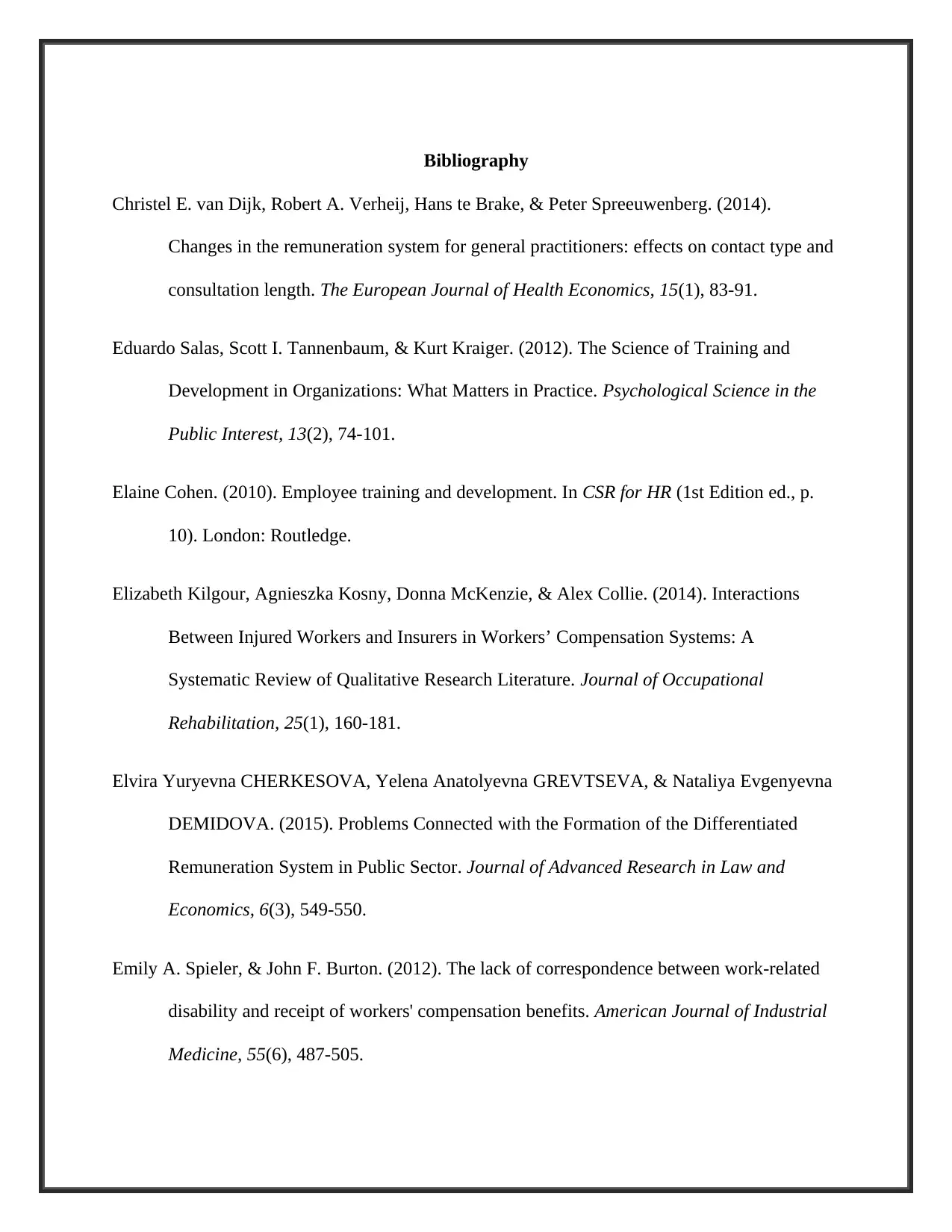
Bibliography
Christel E. van Dijk, Robert A. Verheij, Hans te Brake, & Peter Spreeuwenberg. (2014).
Changes in the remuneration system for general practitioners: effects on contact type and
consultation length. The European Journal of Health Economics, 15(1), 83-91.
Eduardo Salas, Scott I. Tannenbaum, & Kurt Kraiger. (2012). The Science of Training and
Development in Organizations: What Matters in Practice. Psychological Science in the
Public Interest, 13(2), 74-101.
Elaine Cohen. (2010). Employee training and development. In CSR for HR (1st Edition ed., p.
10). London: Routledge.
Elizabeth Kilgour, Agnieszka Kosny, Donna McKenzie, & Alex Collie. (2014). Interactions
Between Injured Workers and Insurers in Workers’ Compensation Systems: A
Systematic Review of Qualitative Research Literature. Journal of Occupational
Rehabilitation, 25(1), 160-181.
Elvira Yuryevna CHERKESOVA, Yelena Anatolyevna GREVTSEVA, & Nataliya Evgenyevna
DEMIDOVA. (2015). Problems Connected with the Formation of the Differentiated
Remuneration System in Public Sector. Journal of Advanced Research in Law and
Economics, 6(3), 549-550.
Emily A. Spieler, & John F. Burton. (2012). The lack of correspondence between work‐related
disability and receipt of workers' compensation benefits. American Journal of Industrial
Medicine, 55(6), 487-505.
Christel E. van Dijk, Robert A. Verheij, Hans te Brake, & Peter Spreeuwenberg. (2014).
Changes in the remuneration system for general practitioners: effects on contact type and
consultation length. The European Journal of Health Economics, 15(1), 83-91.
Eduardo Salas, Scott I. Tannenbaum, & Kurt Kraiger. (2012). The Science of Training and
Development in Organizations: What Matters in Practice. Psychological Science in the
Public Interest, 13(2), 74-101.
Elaine Cohen. (2010). Employee training and development. In CSR for HR (1st Edition ed., p.
10). London: Routledge.
Elizabeth Kilgour, Agnieszka Kosny, Donna McKenzie, & Alex Collie. (2014). Interactions
Between Injured Workers and Insurers in Workers’ Compensation Systems: A
Systematic Review of Qualitative Research Literature. Journal of Occupational
Rehabilitation, 25(1), 160-181.
Elvira Yuryevna CHERKESOVA, Yelena Anatolyevna GREVTSEVA, & Nataliya Evgenyevna
DEMIDOVA. (2015). Problems Connected with the Formation of the Differentiated
Remuneration System in Public Sector. Journal of Advanced Research in Law and
Economics, 6(3), 549-550.
Emily A. Spieler, & John F. Burton. (2012). The lack of correspondence between work‐related
disability and receipt of workers' compensation benefits. American Journal of Industrial
Medicine, 55(6), 487-505.
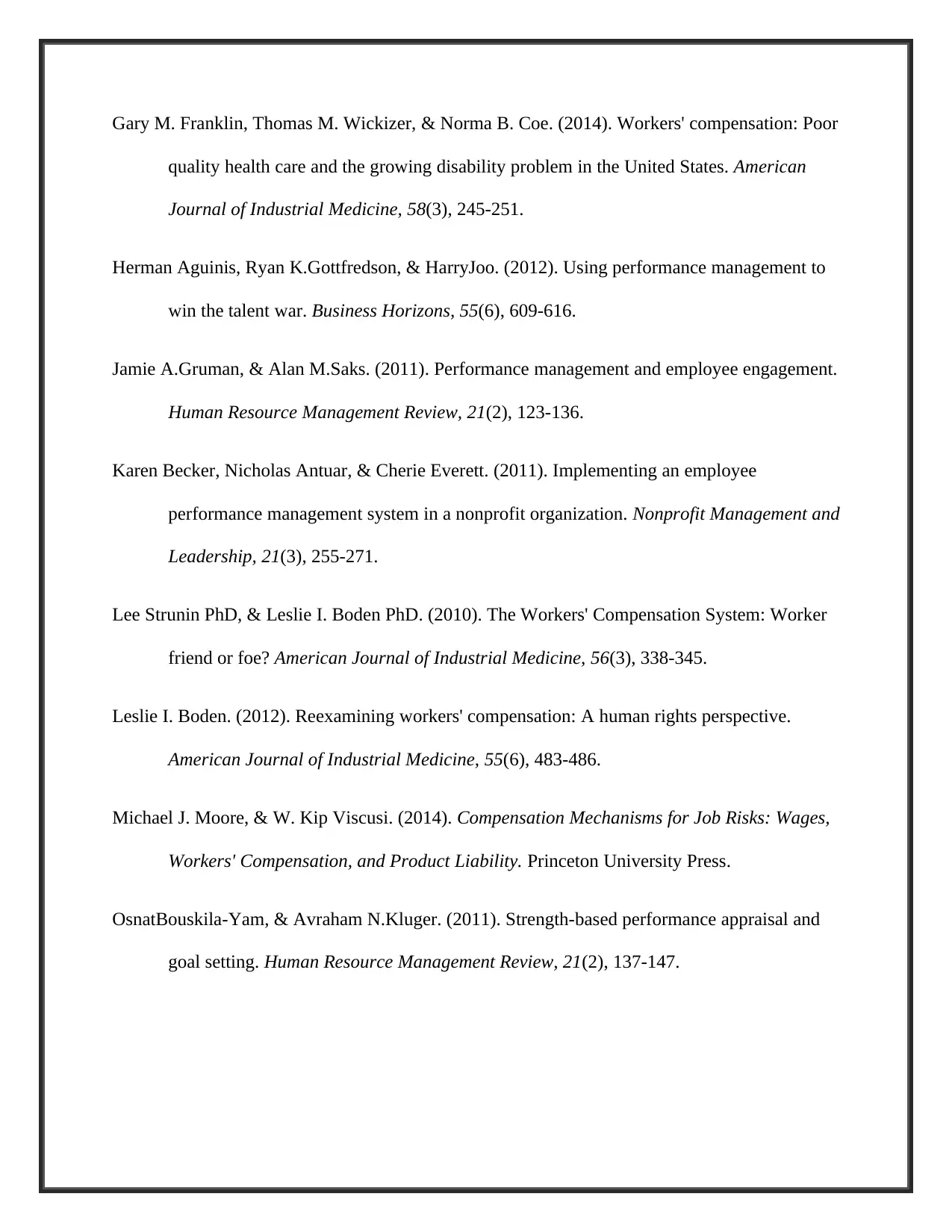
Gary M. Franklin, Thomas M. Wickizer, & Norma B. Coe. (2014). Workers' compensation: Poor
quality health care and the growing disability problem in the United States. American
Journal of Industrial Medicine, 58(3), 245-251.
Herman Aguinis, Ryan K.Gottfredson, & HarryJoo. (2012). Using performance management to
win the talent war. Business Horizons, 55(6), 609-616.
Jamie A.Gruman, & Alan M.Saks. (2011). Performance management and employee engagement.
Human Resource Management Review, 21(2), 123-136.
Karen Becker, Nicholas Antuar, & Cherie Everett. (2011). Implementing an employee
performance management system in a nonprofit organization. Nonprofit Management and
Leadership, 21(3), 255-271.
Lee Strunin PhD, & Leslie I. Boden PhD. (2010). The Workers' Compensation System: Worker
friend or foe? American Journal of Industrial Medicine, 56(3), 338-345.
Leslie I. Boden. (2012). Reexamining workers' compensation: A human rights perspective.
American Journal of Industrial Medicine, 55(6), 483-486.
Michael J. Moore, & W. Kip Viscusi. (2014). Compensation Mechanisms for Job Risks: Wages,
Workers' Compensation, and Product Liability. Princeton University Press.
OsnatBouskila-Yam, & Avraham N.Kluger. (2011). Strength-based performance appraisal and
goal setting. Human Resource Management Review, 21(2), 137-147.
quality health care and the growing disability problem in the United States. American
Journal of Industrial Medicine, 58(3), 245-251.
Herman Aguinis, Ryan K.Gottfredson, & HarryJoo. (2012). Using performance management to
win the talent war. Business Horizons, 55(6), 609-616.
Jamie A.Gruman, & Alan M.Saks. (2011). Performance management and employee engagement.
Human Resource Management Review, 21(2), 123-136.
Karen Becker, Nicholas Antuar, & Cherie Everett. (2011). Implementing an employee
performance management system in a nonprofit organization. Nonprofit Management and
Leadership, 21(3), 255-271.
Lee Strunin PhD, & Leslie I. Boden PhD. (2010). The Workers' Compensation System: Worker
friend or foe? American Journal of Industrial Medicine, 56(3), 338-345.
Leslie I. Boden. (2012). Reexamining workers' compensation: A human rights perspective.
American Journal of Industrial Medicine, 55(6), 483-486.
Michael J. Moore, & W. Kip Viscusi. (2014). Compensation Mechanisms for Job Risks: Wages,
Workers' Compensation, and Product Liability. Princeton University Press.
OsnatBouskila-Yam, & Avraham N.Kluger. (2011). Strength-based performance appraisal and
goal setting. Human Resource Management Review, 21(2), 137-147.
1 out of 13
Your All-in-One AI-Powered Toolkit for Academic Success.
+13062052269
info@desklib.com
Available 24*7 on WhatsApp / Email
![[object Object]](/_next/static/media/star-bottom.7253800d.svg)
Unlock your academic potential
© 2024 | Zucol Services PVT LTD | All rights reserved.



